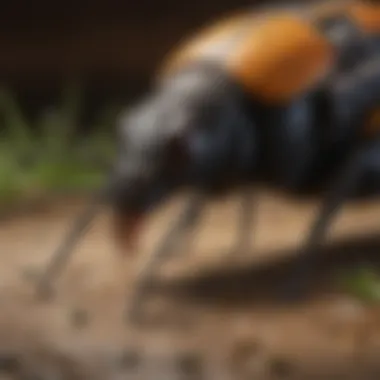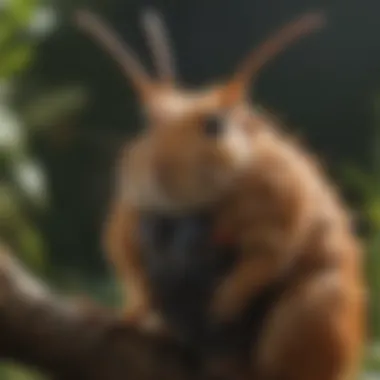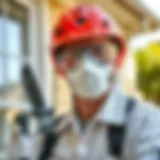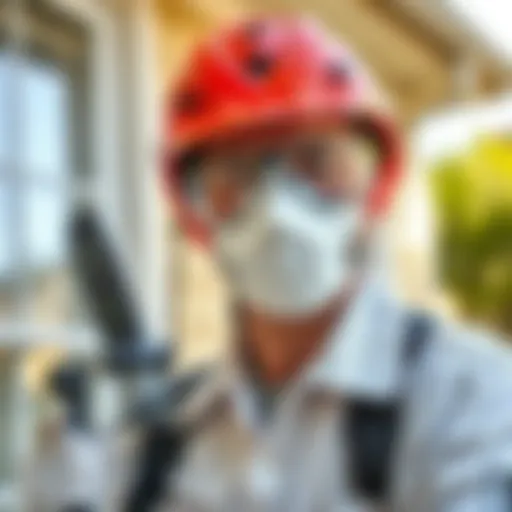Innovative Wildlife and Pest Control Strategies


Intro
In the intricate tapestry of home life, homeowners often encounter a multitude of unwelcome guests, ranging from pesky insects to elusive wildlife. The intricate dance between humans and these creatures calls for advanced strategies, particularly in wildlife and pest control. For those wanting to keep their living spaces comfortable yet intact, understanding how to identify pests effectively, employ preventative measures, and select the right treatment options is key.
Pest Identification
Identifying pests is the first step toward effective management. Recognizing what’s wandering or creeping through your space can make all the difference. Let’s delve into some common pests you may encounter:
- Ants: Hardworking little critters often parade in straight lines. These social insects can be a nuisance, especially when looking for food. They leave a pheromone trail that invites others to their find, so spotting a few can signal a much larger issue.
- Termites: Often referred to as "silent destroyers," termites can go unnoticed until they’ve caused significant damage. Signs include hollow-sounding wood, discarded wings, or frass (termite droppings).
- Rodents: Mice and rats can be crafty. Look for nests made from paper products, tiny droppings, or chewed wires and boxes. The gnaw marks can often lead you straight to their hideouts.
Signs and Symptoms of Infestations
Monitoring your surroundings for signs of infestations is paramount. Here are some indicators that help reveal their presence:
- Sound: Scratching noises in the walls or ceilings, especially at night, can suggest the presence of rodents.
- Smells: A musky odor may signal a rodent problem, while a sweet, rotten smell might be a warning of larger pest issues, such as dead animals.
- Visual Cues: Discarded wings near windows or traps, droppings, or even the pests themselves can serve as alarming signs.
Prevention Strategies
To keep these uninvited guests at bay, implementing strong prevention strategies is crucial:
- Home Maintenance Tips: Regular maintenance around the home goes a long way. Some tips include:
- Natural Deterrents and Barriers: Before resorting to chemicals, consider these natural options:
- Sealing cracks and openings around windows and doors.
- Keeping gutters and downspouts clean.
- Properly storing food in sealed containers to reduce attraction.
- Essential oils such as peppermint, eucalyptus, or tea tree oil can repel insects when mixed with water and sprayed in strategic areas.
- Planting herbs like basil or lavender around the house can also deter pests naturally.
Treatment Options
When prevention fails, understanding treatment options becomes essential:
- Overview of Chemical vs. Natural Treatments: Chemical treatments offer robust solutions, while natural treatments are often more eco-friendly, yet may require more frequent applications:
- Step-by-Step Guides for DIY Treatments: Implementing your own pest management strategies can save time and money, so here’s a general process:
- Chemical options include baits, sprays, and traps specifically designed for the pest.
- Natural options can involve diatomaceous earth or boric acid for ants and roaches.
- Identify the specific pest troubling your space.
- Choose an appropriate method of treatment based on the pest and your home environment.
- Carefully follow the application instructions for whatever treatment you select.
- Monitor the area for effectiveness and reapply as necessary.
"Taking control over your living space by effective pest identification and management methods helps create a safe environment for families and pets."
As pest control is an ongoing process, understanding the adaptable and evolving nature of these practices is beneficial for anyone. By treating the issue comprehensively, one can foster a harmonious coexistence between homes and their wild neighbors.
Understanding the Importance of Advanced Control Techniques
In the realm of pest and wildlife management, the adage, "A stitch in time saves nine," could not ring more true. Advanced control techniques are no longer just a luxury; they have evolved into a necessity for achieving effective and sustainable solutions. With the changing landscape of our environment, where human encroachment is increasingly common, the need for effective management strategies is paramount. This section aims to underscore why embracing such techniques is not just beneficial but crucial for both homeowners and pest control professionals alike.
The Evolving Landscape of Pest Control
The world we inhabit is in constant flux. As urban areas expand and natural habitats are reshaped, the interface between human habitation and wildlife becomes ever more intricate. Traditional pest control methods, often reactive in nature, are losing their efficacy. For instance, take the common issue of rodents in residential areas. With urban sprawls providing ample resources, the rodent population burgeons, leading to infestations. Simply setting traps or using baits may not suffice anymore, especially when considering factors like resistance and behavioral changes.
Today, management strategies must adapt to these new realities. An advanced approach incorporates not only physical control but also biological, ecological, and technological elements. Utilizing GPS tracking for monitoring pest movements, for example, has become a game changer. This proactive strategy allows for targeted interventions, minimizing potential damage and improving resource use. As technology continues to advance, the pest control landscape transforms, emphasizing a need for continuous adaptation and learning.
Why Conventional Methods Are Insufficient
Relying solely on conventional methods can often be like trying to shove a square peg into a round hole – frustrating and ineffective. Traditional approaches, such as blanket pesticide spraying or sporadic trapping, may provide temporary relief but often fail to address the root causes of pest problems. Consider the widespread use of chemical pesticides: while they can eliminate pests quickly, they can also lead to resistance over time, rendering them less effective and causing harm to beneficial insects and the environment.
Moreover, these methods typically lack a sustainable outlook. They do not factor in the ecological balance, which can lead to unintended consequences like the resurgence of more resilient pests or detrimental effects on non-target species. Understanding the biological and behavioral patterns of both pests and wildlife is essential for crafting long-term solutions. The advanced techniques, including Integrated Pest Management (IPM), shift the focus from mere eradication to a more holistic, informed strategy.
"Pest control isn't just about killing bugs; it's about understanding the ecosystem as a whole."
As homeowners gain awareness of the potential pitfalls of outdated techniques, there's a burgeoning demand for smarter, more sustainable practices. This evolution in mindset represents a significant step toward more effective pest management solutions, which ultimately safeguard both human health and our shared environment.


In the following sections, we will delve deeper into the pillars of integrated pest management, technological innovations, and the sustainable practices that can elevate pest control strategies beyond conventional limitations.
Integrated Pest Management as a Framework
In the realm of wildlife and pest control, Integrated Pest Management (IPM) serves as the backbone of successful strategies. This systematic approach leverages a range of methods to manage pest populations effectively while minimizing harm to the environment. It significantly contributes to sustainable practices—something that is now imprinted in the ethos of conscientious homeowners and wildlife managers. Gone are the days of reliance on just a can of spray; today's pest control requires a more nuanced, multi-faceted methodology that not only addresses immediate threats but also considers the long-term health of ecosystems.
Defining Integrated Pest Management
Integrated Pest Management can be best understood as a strategic framework intertwining various techniques aimed precisely at keeping pests in check. This framework is about more than just reacting to pest problems; it’s about anticipating them, understanding the interplay of various organisms in a habitat, and employing responsible techniques accordingly. IPM combines cultural, biological, physical, and chemical practices in a manner that is as holistic as possible. This results in pest control tailored specifically to the nuances of a given environment.
Key Principles of Integrated Pest Management
Prevention
Prevention is, arguably, the cornerstone of Integrated Pest Management. This approach focuses on proactive measures that reduce the likelihood of pest infestations. For example, ensuring proper sanitation around the home, sealing entry points, and controlling moisture can significantly discourage pests from even considering your space as their next residence. What's particularly significant about this principle is its sustainability; by reducing the need for chemical interventions, you maintain a healthier environment both indoors and outdoors.
One unique feature of prevention is that it's often low-cost; simple modifications in household habits can lead to substantial long-term benefits. However, there can be drawbacks if preventive measures are not consistently enforced, like the idea that a one-time cleaning will suffice. Adopting a preventative stance requires a shift in mentality—one that may take time but is crucial for success in pest management.
Monitoring
Monitoring involves regular observations of pest activity and the condition of your property. This not only helps in identifying potential problems early but also assists in making informed decisions about what actions need to be taken. Utilizing tools like traps and inspections can provide crucial insights into pest behavior and patterns, forming the basis for a tailored pest management strategy.
An interesting aspect of monitoring is its adaptability; technology now aids these efforts through smart monitoring systems that offer remote insights, allowing for timely actions even when you're away from home. Yet, this technique requires diligence—failing to monitor regularly can lead to outbreaks that escalate beyond control, resulting in costly interventions later.
Control Strategies
Control Strategies encapsulate the myriad of options available to deal with pest threats once they have been identified. IPM encourages the use of multiple tactics—chemical controls, biological controls, and even manual removal. The beauty of integrating various strategies lies in the ability to pivot based on what proves to be more effective, thus ensuring that no single method is over-relied upon.
For homeowners, this flexibility is beneficial as it allows for tailored approaches. However, potential drawbacks include the confusion that might arise when multiple strategies are employed simultaneously; coordination can be tricky. It's crucial to have a clear plan or consultation from professionals to execute these strategies efficiently.
Benefits of an Integrated Approach
Employment of Integrated Pest Management brings several advantages, both for the immediate needs of pest control and the broader ecological context. It fosters a healthier living environment by reducing the volume of chemicals used and promoting biodiversity. Additionally, it can lead to cost savings over time, as addressing pest issues before they become widespread often requires less investment.
Taking the integrated route means that homeowners are part of the solution, engaging with their environment in a more responsible way. As they gain insights into the ecosystems surrounding their homes, they also build a greater sense of stewardship towards these spaces, ensuring both their protection and that of the wildlife inhabiting them.
Technological Innovations in Pest Control
Technological innovations are reshaping the way we think about pest control. This paradigm shift is not just a fleeting trend, but a vital element in our ongoing effort to manage pests and wildlife more effectively. Nowadays, many homeowners find themselves at the crossroads of traditional methods and advanced technologies. It is here that the integration of tech offers promising routes for effective management.
The tools available today, from automated systems to biopesticides, significantly enhance accuracy and efficiency in pest control. Automation reduces the labor-intensive aspects of these tasks, while smart technology aids in real-time monitoring and analysis. This convergence of technology and pest management introduces new possibilities that are tailored to the specific needs of residential settings.
Automation and Robotics
In the realm of pest control, automation and robotics are not just buzzwords. They represent real change in how pest problems are approached. Automated systems can operate continuously, reducing the need for constant human intervention. Robots can inspect and treat areas that might be hard to reach or hazardous for humans, such as attics or under floors.
Picture this: a robotic system designed to roam around your garden, identifying areas of concern. For homeowners or even those managing larger landscapes, this type of technology not only minimizes exposure to harmful substances but also directs its focus where it’s needed the most. The consistent application of solutions can result in a reduction of overall pest populations, making life easier and healthier.
Smart Monitoring Systems
Remote Sensing
Remote sensing has emerged as a crucial tool in modern pest control strategies. This technology allows for the detection of pest activity without the need for physical presence. By utilizing drones or satellite imaging, homeowners can gain insights into problem areas before they turn into full-blown infestations. The key characteristic here is its ability to provide real-time insight into pest populations, highlighting hotspots of activity.
Remote sensing helps alleviate the guesswork in pest management, providing reliable data that can inform intervention strategies. One unique feature of remote sensing is its capability to assess large areas efficiently, which is invaluable for those managing extensive properties. However, it’s worth mentioning that while remote sensing is a highly beneficial choice, its initial setup cost may present a hurdle for some.
Data Analytics
Data analytics takes things a step further by allowing for aggregation and analysis of pest-related data. The collection of data—from pest sighting trends to environmental conditions—enables homeowners to react proactively. One key highlight of data analytics is its capacity for trend identification. By recognizing patterns over time, homeowners can anticipate and mitigate potential pest issues before they arise.


Moreover, the unique feature of data analytics lies in its predictive capabilities. For instance, if an uptick in rodent sightings correlates with a specific season, a homeowner can take preventive measures ahead of time. Still, it’s essential to recognize that reliance on data-driven decision-making requires accurate data collection, rendering the effectiveness contingent upon the quality of the data being monitored.
Biopesticides and Natural Solutions
Biopesticides and natural solutions are gaining prominence as environmentally friendly alternatives to traditional pesticides. Leveraging naturally occurring substances, these products target pests while minimizing adverse effects on the surrounding ecosystem. They spark interest for many homeowners who are increasingly conscious of their ecological footprint.
The benefits of these solutions include their reduced toxicity levels and a lower likelihood of pest resistance developing over time. This makes them not only safer for your family but also advantageous for long-term pest management strategies. As awareness grows, more homeowners are turning to these alternatives, recognizing the balance they strike between effective pest control and environmental responsibility.
Wildlife Management Techniques
Effective wildlife management techniques play a crucial role in controlling both pests and potentially problematic wildlife species. This approach is about balancing ecosystem health while safeguarding residential properties. The need for humane, effective management strategies cannot be overstated, especially in suburban areas where the natural habitat and human living areas overlap. Understanding these techniques helps homeowners minimize damage, reduce risks, and foster coexistence with local wildlife.
Habitat Modification
Habitat modification involves altering the environment to discourage wildlife from taking up residence in unwanted areas. Common strategies may involve clearing away debris, maintaining gardens with secure fencing, or even employing landscaping techniques that deter certain species. For instance, if your yard becomes a buffet for local deer, planting thorny bushes can create a more challenging environment for them. Moreover, managing standing water can help in controlling mosquito populations, which are drawn to stagnant areas.
Benefits of habitat modification include:
- Reduced Wildlife Encounters: A less inviting environment leads to fewer animals scouting for food and shelter.
- Eco-friendly Solutions: Unlike pesticide use, habitat modification often complies with environmental standards.
- Improved Property Aesthetics: Thoughtfully designed areas can enhance the overall look of a home while serving a practical purpose.
Exclusion Methods
Exclusion is a proactive approach to wildlife and pest control. It involves sealing off entry points that animals and insects may use to invade your space. This can be achieved through various methods such as installing barriers, screens, and securing soil or plant beds. For instance, if you notice that squirrels have made a habit of raiding your attic, consider installing metal mesh over vents and gaps in roofing.
Key points regarding exclusion methods include:
- Permanent Solutions: Addressing potential entry points can offer long-term peace of mind for homeowners.
- Cost-effective: Preventing access is generally more affordable than dealing with pest aftermath.
- Less Harmful: This method focuses on keeping wildlife at bay without resorting to lethal measures, aligning with modern ethical considerations in pest control.
Relocation and Rehabilitation Strategies
When wildlife poses a direct threat or issue, such as raccoons rummaging through bins, relocation becomes an option worth considering. However, it's important to follow local regulations regarding trapping and moving wildlife. Relocation efforts may need to consider the animal's best interest, ensuring they are not simply dropped in an area where they are ill-equipped to thrive. Rehabilitation centers often provide care for animals in need, promoting a healthier approach to animal management while considering their original habitats.
Highlights of relocation and rehabilitation include:
- Public Responsibility: By adopting humane methods, society demonstrates its commitment to ethical treatment of urban wildlife.
- Education Opportunities: These programs often educate the public about local wildlife, fostering a deeper understanding and appreciation.
- Community Support Systems: Engaging local professionals or rehabilitation organizations connects homeowners with expert advice tailored to their specific location and concerns.
Incorporating effective wildlife management techniques can go a long way in maintaining a harmonious living space while respecting the natural world. Whether through habitat modification, exclusion methods, or thoughtful relocation and rehabilitation, a informed approach tailors solutions to fit unique circumstances. This understanding not only encourages responsible management but also promotes a healthier ecosystem for all.
Sustainable Practices in Pest Control
When it comes to managing pests in and around our homes, sustainable practices play an essential role. These strategies not only focus on eradicating pests but do so in a way that minimizes harm to the environment. Homeowners, in particular, benefit greatly from adopting these approaches, as they align with an increasing desire for greener living and eco-friendly solutions.
Sustainable practices in pest control can be summarized through several key elements, each contributing to a more holistic approach:
- Preventive Measures: This includes simple actions like sealing gaps in walls or ensuring that trash is stored properly. It’s not just about reacting to pests but taking steps to stop infestations before they begin.
- Ecological Balance: By understanding the ecosystem in their backyard, homeowners can promote natural pest predators, such as ladybugs for aphids or spiders that help control various insect populations.
- Resource Efficiency: Using less chemical pesticides not only protects beneficial organisms but also reduces the chances of pest resistance developing over time.
Embracing these practices fosters a sense of stewardship over one’s environment, leading to multiple benefits.
Environmental Impact Considerations
Sustainable practices intrinsically consider the environment. As homeowners explore pest control options, it’s vital to weigh the consequences of their choices on local ecosystems. For instance, synthetic pesticides may offer quick results but can also contaminate soil and water sources, endangering both wildlife and human health.
- Biodiversity: Pests are part and parcel of nature, and some are essential for maintaining the balance of the ecosystem. Utilizing sustainable methods ensures that this balance is preserved.
- Water Quality: Runoff from treated areas can lead to pesticides entering water systems. Sustainable methods often incorporate organic alternatives that are less harmful.
- Soil Health: Some chemical treatments can disrupt beneficial microorganisms in the soil which play essential roles in plant health.
"Incorporating sustainable pest management practices is not merely a trend; it’s a vital step toward preserving our environment for future generations."
The Role of Community Involvement
Sustainable pest control goes beyond individual households. Community involvement is pivotal in creating a larger impact. When neighborhoods pool their efforts, the results can be remarkable. Here’s how community engagement plays a role:


- Education and Awareness Campaigns: Communities that work together can educate one another about effective pest management strategies, sharing knowledge that fosters better practices throughout the area.
- Shared Resources: By pooling together tools and resources such as compost bins or community gardens, neighbors reduce costs and provide safer environments for themselves and local wildlife.
- Collective Responsibility: When a community is united in its pest control efforts, it not only enhances the efficacy of those methods but also builds camaraderie as they tackle challenges together.
Homeowners have a unique opportunity to lead by example. Being proactive in their own pest management can inspire others to do the same, thus transforming individual actions into community-wide movements.
Overall, sustainable practices in pest control are not just beneficial—they are essential. The harmony between proactive management, environmental care, and community collaboration can truly transform how we coexist with nature around us.
Challenges in Wildlife and Pest Management
Understanding the hurdles in wildlife and pest management is crucial for anyone involved in this field. These challenges not only dictate how effectively one can manage nuisance species but also shape the strategies used to create a harmonious environment in urban and rural settings. As the landscape of pest control continues to evolve, recognizing these obstacles provides a foundation for developing efficient and sustainable management practices.
Resistance to Control Techniques
One pressing issue in pest management is the resistance to control techniques. Over time, many pests have developed increased tolerance to certain pesticides due to repeated exposure. This has made once-effective methods less reliable, pushing pest control specialists to constantly adapt their strategies.
A common example here involves the American cockroach, which has shown declining sensitivity to traditional insecticides. Homeowners might feel frustrated when they find that the same products they previously relied upon are no longer effective.
- Biological Factors: Pests adapt and reproduce quickly, meaning that resistance can spread swiftly through populations. When using chemical techniques without consideration for resistance, one may be setting themselves up for expensive and time-consuming battles in the future.
- Diversification in Approaches: Integrating diverse management methods is vital. This could mean alternating different classes of insecticides or incorporating non-chemical methods alongside chemical solutions. Being proactive is key. If you see repeated failures with certain treatments, it’s essential to rethink your strategy to avoid creating more resilient pest populations.
"Adapt or perish, now as ever, is nature's inexorable imperative." – H.G. Wells
Regulatory Issues and Compliance
Navigating the regulatory landscape can feel like walking through a minefield for many involved in wildlife and pest management. Various government bodies impose regulations on pest control substances, which can complicate day-to-day operations. Homeowners and pest management professionals both bear the brunt of these complexities.
- Licensing and Certification: Compliance with local and national laws is not just a formality; it's a necessity. Pest control professionals must maintain proper licensing, and staying updated with the latest regulations is vital to ensure that the practices used are legal and safe. Individuals venturing into DIY pest control also need awareness. Ignorance can lead to hefty fines or, worse, environmental damage.
- Environmental Standards: Strict regulations protect local ecosystems from the adverse effects of certain pest control methods. When a pest control company applies chemical solutions, they must often follow environmental guidelines that dictate where and how these substances can be utilized. Ignoring these can have severe repercussions, both legally and environmentally.
- Transparency and Community Impact: Gradually, communities are becoming more engaged in questioning pest control practices, pushing both companies and homeowners towards transparency. Understanding and participating in discussions related to regulation can create a more informed and responsible approach to pest management.
Future Directions in Pest and Wildlife Control
The terrain of pest and wildlife management is continually shifting, and staying abreast of these changes is crucial for effective control strategies. As urbanization increases and human-animal interactions escalate, the role of advanced techniques becomes more significant. Understanding the future directions in this field helps us not just in maintaining our properties but in ensuring harmonious coexistence with the creatures sharing our environment.
Emerging Trends and Technologies
In recent years, several trends have emerged that underline the importance of innovation in wildlife and pest control. These trends include the integration of technology, development of novel pest control substances, and environmentally sustainable practices.
- Drone Technology: Utilizing drones for monitoring pest movements and assessing wildlife populations has become increasingly popular. These unmanned aerial vehicles can cover extensive areas quickly and without disturbing the ecosystem.
- AI and Machine Learning: By harnessing big data, predictive analytics can forecast pest activity based on environmental factors. This proactive strategy can save resources and react before problems escalate.
- Biological Control Methods: Employing natural predators and parasites to manage pest populations is a practice gaining traction. This not only lessens the need for chemical interventions but promotes biodiversity, making it a win-win for the environment.
It's imperative to recognize that these advancements are not just flashy novelties; they provide practical solutions that can significantly enhance the effectiveness of management practices while reducing environmental impact.
The Importance of Continuous Education
As the landscape of pest and wildlife control changes, so should the knowledge of those who manage it. Continuous education stands out as a cornerstone for success in the field. Here’s why:
- Adapting to New Regulations: The legal frameworks surrounding pest control are always on the move. Understanding the latest laws and guidelines helps professionals stay compliant and maintain ethical standards.
- Staying Current with Best Practices: Techniques that were once the gold standard may become obsolete. Ongoing training ensures that pest control experts and homeowners alike are aware of the best methods that yield effective results without breaching environmental ethics.
- Improving Community Engagement: Educated individuals are better equipped to inform their communities about pest management strategies, thereby fostering a culture of awareness and prevention.
Keeping firmly in the loop fosters not just personal growth but communal stewardship. The more informed we are, the better we can nurture our environment.
The relationships between technology, education, and environmental awareness cannot be overstated. When these elements come together, pest and wildlife management becomes not just a necessity, but an opportunity to cultivate a healthier habitat for all living things.
The End: The Call for Advanced Practices
Wildlife and pest control is not simply a matter of eradicating annoying visitors or destructive critters. It’s about creating a sustainable balance, one that respects both the environment and our homes. This article underscores the urgent need for advanced practices that combine scientific research with practical implementation. By advocating for innovative strategies, we pave the way towards more efficient and effective management techniques that address current challenges.
The integration of modern technology, regulatory compliance, and community involvement can dramatically improve our approach to pest and wildlife management. These advanced practices not only enhance effectiveness, but they also minimize environmental impact - a win-win situation, if you will. Homeowners reviewing pest control options should seek solutions that look beyond traditional methods, operating under the belief that proficiency in knowledge translates to actionable steps.
It's important to recognize that passive solutions—ones that simply wait for pests to act—aren't going to cut it anymore. Instead of just reacting when challenges arise, a proactive mindset needs to be woven into daily practices. Homeowners who understand the broader implications of wildlife management can make informed decisions that recognize both the value of their indoor spaces and the ecosystem surrounding them.
Integrating Knowledge and Action
The cornerstone of any effective management strategy lies in this principle: pairing knowledge with decisive action. When homeowners arm themselves with the right information, they set the stage for significant impact.
For example:
- Preventative Measures: Understanding local wildlife habits can lead to smarter choices in garden design and food storage, thereby deterring unwanted guests before they arrive.
- Methods of Monitoring: Utilizing smart monitoring systems enables real-time data collection, prompting swift responses to emerging issues.
- Community Education: Engaging with neighbors and sharing information fosters a communal effort in wildlife management. Collective action can significantly amplify individual efforts.
Consider the saying, “An ounce of prevention is worth a pound of cure.” This underscores the idea that early action softens the blow of potential problems that could arise down the road. It encourages a problem-solving philosophy that aligns perfectly with the notion of integrated pest management.
By fostering a culture where knowledge guides action, we can develop comprehensive strategies that do not merely aim at control but strive for harmonious cohabitation. It calls on homeowners to not just think like solitary agents in the fight against pests but as integral parts of a larger environmental picture. Through such synergy, pest control becomes a shared responsibility, contributing to healthier living spaces and ecosystems.



